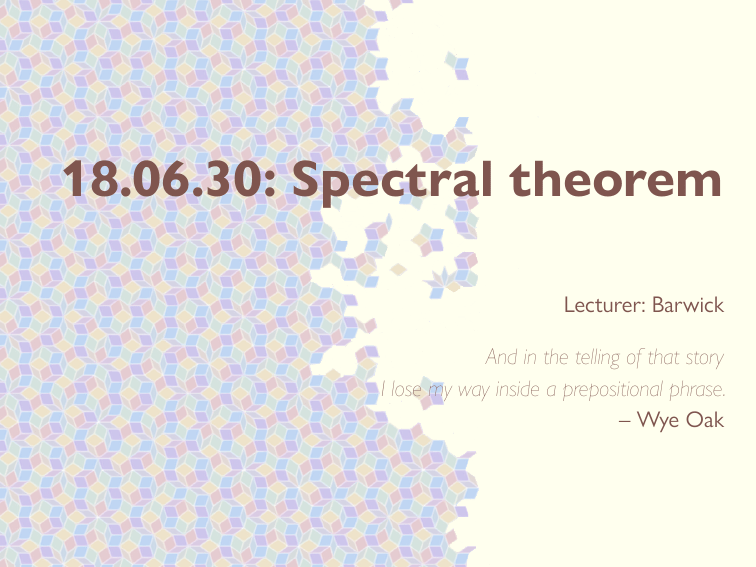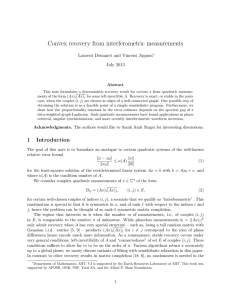18.06.30: Spectral theorem
advertisement

18.06.30: Spectral theorem
Lecturer: Barwick
And in the telling of that story
I lose my way inside a prepositional phrase.
– Wye Oak
18.06.30: Spectral theorem
For 𝑣, 𝑤 ∈ C𝑛 , write
⟨𝑣|𝑤⟩ ≔ 𝑣∗ 𝑤.
This is a complex number, called the inner product of two complex vectors; it
extends the usual dot product, but notices that the linearity in the first coordinate is twisted:
⟨𝛼𝑣|𝑤⟩ = 𝛼⟨𝑣|𝑤⟩ but ⟨𝑣|𝛼𝑤⟩ = 𝛼⟨𝑣|𝑤⟩.
The length of a vector 𝑣 ∈ C𝑛 is defined by ||𝑣||2 = ⟨𝑣|𝑣⟩; it’s precisely the same
as the length of the corresponding vector in R2𝑛 . (Why??)
18.06.30: Spectral theorem
Lemma. An 𝑛 × 𝑛 complex matrix 𝐵 is Hermitian if and only if, for any 𝑣, 𝑤 ∈
C𝑛 ,
⟨𝐴𝑣|𝑤⟩ = ⟨𝑣|𝐴𝑤⟩.
Proof. If 𝐴 is Hermitian, then (𝐴𝑣)∗ 𝑤 = 𝑣∗ 𝐴∗ 𝑤 = 𝑣∗ 𝐴𝑤.
On the other hand, suppose that for any 𝑣, 𝑤 ∈ C𝑛 ,
⟨𝐴𝑣|𝑤⟩ = ⟨𝑣|𝐴𝑤⟩.
Then when 𝑣 = 𝑒𝑖̂ and 𝑤 = 𝑒𝑗̂ , this equation becomes
𝑎𝑗𝑖 = (𝐴𝑖 )∗ 𝑒𝑗̂ = 𝑒𝑖∗̂ 𝐴𝑗 = 𝑎𝑖𝑗 .
18.06.30: Spectral theorem
Theorem (Spectral theorem; last big result of the semester). Suppose 𝐵 a Hermitian matrix. Then
(1) The eigenvalues of 𝐵 are real.
(2) There is an orthogonal basis of eigenvectors for 𝐵; in particular, 𝐵 is diagonalizable over C (and even over R if 𝐵 has real entries).
18.06.30: Spectral theorem
Proof. Let’s first see why the eigenvalues of 𝐵 must be real. Suppose 𝑣 ∈ C𝑛 an
eigenvector of 𝐵 with eigenvalue 𝜆, so that 𝐵𝑣 = 𝜆𝑣. Then,
𝜆||𝑣||2 = 𝜆⟨𝑣|𝑣⟩ = ⟨𝑣|𝜆𝑣⟩
= ⟨𝑣|𝐵𝑣⟩
= ⟨𝐵𝑣|𝑣⟩
= ⟨𝜆𝑣|𝑣⟩
= 𝜆⟨𝑣|𝑣⟩ = 𝜆||𝑣||2 .
Since 𝑣 ≠ 0, one has ||𝑣|| ≠ 0, whence 𝜆 = 𝜆.
18.06.30: Spectral theorem
Now let’s see about that orthogonal basis of eigenvectors. Using the Fundamental Theorem of Algebra, write the characteristic polynomial
𝑝𝐵 (𝑡) = (𝑡 − 𝜆1 ) ⋯ (𝑡 − 𝜆𝑛 ),
where 𝜆1 , … , 𝜆𝑛 ∈ C are the roots of 𝑝𝐵 . We may not assume that the 𝜆𝑖 ’s are
distinct!!
Let’s choose an eigenvector 𝑣1 with eigenvalue 𝜆1 , and consider the hyperplane
𝑊1 ≔ {𝑤 ∈ C𝑛 | ⟨𝑣1 |𝑤⟩ = 0}.
18.06.30: Spectral theorem
Note that for any 𝑤 ∈ 𝑊1 , one has
⟨𝑣1 |𝐵𝑤⟩ = ⟨𝐵𝑣1 |𝑤⟩ = ⟨𝜆1 𝑣1 |𝐵𝑤⟩ = 𝜆1 ⟨𝑣1 |𝑤⟩ = 0,
so 𝐵𝑤 ∈ 𝑊1 as well. Hence the linear map 𝑇𝐵 ∶ C𝑛
𝑇1 ∶ 𝑊1
𝑊1 .
C𝑛 restricts to a map
18.06.30: Spectral theorem
Select, temporarily, a C-basis {𝑤2 , … , 𝑤𝑛 } of 𝑊1 . Then {𝑣1 , 𝑤2 , … , 𝑤𝑛 } is a
C-basis of C𝑛 , and writing 𝑇𝐵 relative to this basis gives us a matrix
𝐶1 = (
𝜆1 0
),
0 𝐵1
where 𝐵1 is the (𝑛 − 1) × (𝑛 − 1) matrix that represents 𝑇1 relative to the basis
{𝑤2 , … , 𝑤𝑛 }, and
𝑝𝐵1 = (𝑡 − 𝜆2 ) ⋯ (𝑡 − 𝜆𝑛 ).
18.06.30: Spectral theorem
Now we run that same argument again with the (𝑛 − 1) × (𝑛 − 1) matrix 𝐵1 in
place of the 𝑛 × 𝑛 matrix 𝐵 to get:
▶ an eigenvector 𝑣2 ∈ 𝑊1 with eigenvalue 𝜆2 ,
▶ the subspace 𝑊2 ⊂ 𝑊1 of vectors orthogonal to 𝑣2 ,
▶ and an (𝑛 − 2) × (𝑛 − 2) matrix 𝐵2 that represents 𝑇𝐵 restricted to 𝑊2 .
Now we find that 𝐵 is similar to
𝜆1 0 0
𝐶2 = ( 0 𝜆2 0 ) .
0 0 𝐵2
18.06.30: Spectral theorem
We repeat this argument repeatedly on each new 𝐵𝑖 , each time getting:
▶ an eigenvector 𝑣𝑖+1 ∈ 𝑊𝑖 with eigenvalue 𝜆𝑖+1 ,
▶ the subspace 𝑊𝑖+1 ⊂ 𝑊𝑖 of vectors orthogonal to 𝑣𝑖+1 ,
▶ and an (𝑛 − 𝑖 − 1) × (𝑛 − 𝑖 − 1) matrix 𝐵𝑖+1 that represents 𝑇𝐵 restricted
to 𝑊𝑖+1 .
18.06.30: Spectral theorem
At each stage, we find that 𝐵 is similar to
𝐶𝑖+1
𝜆1 0
0 𝜆2
(
=
⋮ ⋮
0 0
( 0 0
⋯ 0
0
⋯ 0
0
⋱ ⋮ ⋮ ).
⋯ 𝜆𝑖
0
⋯ 0 𝐵𝑖+1 )
18.06.30: Spectral theorem
This process eventually stops, when 𝑖 = 𝑛. Then we’re left with:
▶ eigenvectors 𝑣1 , … , 𝑣𝑛 with eigenvalues 𝜆1 , … , 𝜆𝑛 ,
▶ a string of subspaces
C𝑛 = 𝑊0 ⊃ 𝑊1 ⊃ 𝑊2 ⊃ ⋯ ⊃ 𝑊𝑛 = {0},
with 𝑣𝑖+1 ∈ 𝑊𝑖 , and
𝑊𝑖+1 = {𝑤 ∈ 𝑊𝑖 | ⟨𝑣𝑖+1 |𝑤⟩},
▶ and a diagonal matrix 𝐶𝑛 = diag(𝜆1 , … , 𝜆𝑛 ) to which 𝐵 is similar.






